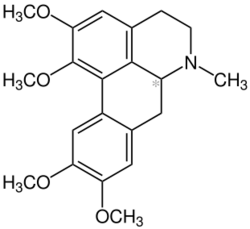Chemistry:Glaucine
 | |
| Clinical data | |
|---|---|
| AHFS/Drugs.com | International Drug Names |
| ATC code |
|
| Identifiers | |
| |
| CAS Number | |
| PubChem CID | |
| ChemSpider | |
| UNII | |
| KEGG | |
| ChEBI | |
| ChEMBL | |
| NIAID ChemDB | |
| Chemical and physical data | |
| Formula | C21H25NO4 |
| Molar mass | 355.434 g·mol−1 |
| 3D model (JSmol) | |
| |
| |
| | |
Glaucine (1,2,9,10-TetraMethoxyAporphine, Bromcholitin, Glauvent, Tusidil, Tussiglaucin) is an aporphine alkaloid found in several different plant species in the family Papaveraceae such as Glaucium flavum,[1] Glaucium oxylobum and Corydalis yanhusuo,[2][3] and in other plants like Croton lechleri in the family Euphorbiaceae.[4]
It has bronchodilator, neuroleptic[5] and antiinflammatory effects, acting as a PDE4 inhibitor and calcium channel blocker,[6] and is used medically as an antitussive in some countries.[7] TLRs plays role in its anti inflammatory effects.[8] Glaucine may produce side effects such as sedation, fatigue, and a hallucinogenic effect characterised by colourful visual images,[9][10] and has been detected as a novel psychoactive drug.[11] In a 2019 publication,[12] the isomer (R)-glaucine is reported to be a positive allosteric modulator of the 5-HT2A receptor, which is also associated with the hallucinogenic effects of substances such as psilocybin and mescaline.
Chemistry
Stereoisomerism
It was believed that only the (S)-form of glaucine occurs in nature until (R)-glaucine was found in fire poppy (Papaver californicum).[13]
| Glaucine (2 stereoisomers) | |
|---|---|
 (S)-configuration |
 (R)-configuration |
Mechanism of action
Glaucine binds to the benzothiazepine site on L-type Ca2+-channels, thereby blocking calcium ion channels in smooth muscle like the human bronchus. Glaucine has no effect on intracellular calcium stores, but rather, does not allow the entry of Ca2+ after intracellular stores have been depleted.[6] Ca2+ influx is a vital component in the process of muscular contraction, and the blocking of this influx therefore reduces the ability of the muscle to contract.[14] In this way, glaucine can prevent smooth muscle from contracting, allowing it to relax.
Glaucine has also been demonstrated to be a dopamine receptor antagonist, favoring D1 and D1-like receptors.[11][15] It is also a non-competitive selective inhibitor of PDE4 in human bronchial tissue and granulocytes. PDE4 is an isoenzyme that hydrolyzes cyclic AMP to regulate human bronchial tone (along with PDE3). Yet as a PDE4 inhibitor, glaucine possesses very low potency.[6]
Glaucine has also recently[12] been found to have an effect on the neuronal 5-HT2A receptors, which are responsible for the hallucinogenic effects of classical psychedelics. It also inhibits MAO enzymes.[16] Its enantiomers effect are same for adrenergic receptor yet different for 5-HT receptor. Both (R)-Glaucine and (S)-Glaucine antagonizes α1 receptor but (S)-Glaucine is partial agonist of 5-HT2 subtypes whereas (R)-Glaucine is positive allosteric modulator of 5-HT2.[17]
Uses
Medical
It is currently used as an antitussive agent in Iceland, as well as Romania, Bulgaria, Russia and other eastern European countries.[6][11] Bulgarian pharmaceutical company Sopharma sells glaucine in tablet form, where a single dose contains 40 mg and the half-life is indicated to be 6–8 hours. When ingested orally has been shown to increase airway conductance in humans, and has been investigated as a treatment for asthma.[6]
Glaucine has been reported to reduce blood pressure, heart rate and possess anticonvulsant and antinoiciceptive effect in animals[18][19]
Recreational
Reports of recreational use of glaucine have recently been published, and effects include dissociative-type symptoms; feeling detached and 'in another world', as well as nausea, vomiting and dilated pupils. These reports mirror those about the effects of clinical use, which state dissociative-type symptoms as well as lethargy, fatigue, hallucinations.[10][11] Investigation of side effects in a clinical setting also reports that the hallucinatory effects manifest as bright and colorful visualizations. They also report that patients perceive their environments clearly yet feel detached from it; "the patient sees and understands everything and is oriented well enough, but cannot take a clear and adequate action".[10]
One particular report of recreational use gone awry described the form of distribution as tablets being marketed as a 1-benzylpiperazine (BZP)-free "herbal high" which the patient referred to as "head candy".[11]
See also
References
- ↑ "HPLC Determination of Glaucine in Yellow Horn Poppy Grass (Glaucium flavum Crantz)". Pharmaceutical Chemistry Journal 38 (1): 441–442. August 2004. doi:10.1023/B:PHAC.0000048907.58847.c6. ISSN 0091-150X. "S-(+)-Glaucine (C21H25NO4) is the main alkaloid component in the grass of yellow horn poppy (Glaucium luteum L., syn. Glaucium flavum Crantz) of the family Papaveraceae".
- ↑ "[Resource investigation and quality evaluation on wild Corydalis yanhusuo]". Zhongguo Zhong Yao Za Zhi = Zhongguo Zhongyao Zazhi = China Journal of Chinese Materia Medica 29 (5): 399–401. May 2004. PMID 15706885.
- ↑ "Antifungal activity of the methanolic extract and alkaloids of Glaucium oxylobum". Fitoterapia 74 (5): 493–6. July 2003. doi:10.1016/s0367-326x(03)00113-8. PMID 12837370.
- ↑ "Geographic distribution of three alkaloid chemotypes of Croton lechleri". Journal of Natural Products 65 (6): 814–9. June 2002. doi:10.1021/np000270v. PMID 12088421.
- ↑ "Neuroleptic-like, anticonvulsant and antinociceptive effects of aporphine alkaloids: bulbocapnine, corytuberine, boldine and glaucine". Archives Internationales de Pharmacodynamie et de Therapie 296: 255–281. 1988. PMID 2907279.
- ↑ 6.0 6.1 6.2 6.3 6.4 "Bronchodilator and anti-inflammatory activities of glaucine: In vitro studies in human airway smooth muscle and polymorphonuclear leukocytes". British Journal of Pharmacology 127 (7): 1641–51. August 1999. doi:10.1038/sj.bjp.0702702. PMID 10455321.
- ↑ "Objective evaluation of dextromethorphan and glaucine as antitussive agents". British Journal of Clinical Pharmacology 17 (5): 521–4. May 1984. doi:10.1111/j.1365-2125.1984.tb02384.x. PMID 6375709.
- ↑ "Toll-like receptor-mediated anti-inflammatory action of glaucine and oxoglaucine". Fitoterapia 80 (7): 411–4. October 2009. doi:10.1016/j.fitote.2009.05.016. PMID 19481591. https://hal-riip.archives-ouvertes.fr/pasteur-00736334/file/Fitoterapia_Ivanovska.pdf.
- ↑ "[A case of hallucinogen-like action of glaucine]". Klinicheskaia Meditsina 67 (9): 107–8. September 1989. PMID 2586025.
- ↑ 10.0 10.1 10.2 "[Acute glaucine syndrome in the physician's practice: the clinical picture and potential danger]". Klinicheskaia Meditsina 84 (11): 68–70. 2006. PMID 17243616.
- ↑ 11.0 11.1 11.2 11.3 11.4 "Detection of the pharmaceutical agent glaucine as a recreational drug". European Journal of Clinical Pharmacology 64 (5): 553–4. May 2008. doi:10.1007/s00228-007-0451-9. PMID 18204834.
- ↑ 12.0 12.1 Heng, HL, Chee, CF, Thy, CK, et al. In vitro functional evaluation of isolaureline, dicentrine and glaucine enantiomers at 5‐HT2 and α1 receptors. Chem Biol Drug Des. 2019; 93: 132– 138. https://doi.org/10.1111/cbdd.13390
- ↑ "A functionally conserved STORR gene fusion in Papaver species that diverged 16.8 million years ago". Nature Communications 13 (1): 3150. June 2022. doi:10.1038/s41467-022-30856-w. PMID 35672295. Bibcode: 2022NatCo..13.3150C.
- ↑ Nestler E, Hyman S & Malenka R. Molecular Neuropharmacology: A Foundation for Clinical Neuroscience (2nd ed.). China: McGraw-Hill Companies.
- ↑ "Structure-affinity relationships of halogenated predicentrine and glaucine derivatives at D1 and D2 dopaminergic receptors: halogenation and D1 receptor selectivity". Bioorganic & Medicinal Chemistry 13 (11): 3699–704. June 2005. doi:10.1016/j.bmc.2005.03.022. PMID 15862999.
- ↑ "Rapid screening and identification of monoamine oxidase-A inhibitors from Corydalis Rhizome using enzyme-immobilized magnetic beads based method". Journal of Chromatography A 1592: 1–8. May 2019. doi:10.1016/j.chroma.2019.01.062. PMID 30712820.
- ↑ "In vitro functional evaluation of isolaureline, dicentrine and glaucine enantiomers at 5-HT2 and α1 receptors". Chemical Biology & Drug Design 93 (2): 132–138. February 2019. doi:10.1111/cbdd.13390. PMID 30216681.
- ↑ "Neuroleptic-like, anticonvulsant and antinociceptive effects of aporphine alkaloids: bulbocapnine, corytuberine, boldine and glaucine". Archives Internationales de Pharmacodynamie et de Therapie 296: 255–81. 1988. PMID 2907279.
- ↑ "Study of the in vivo and in vitro cardiovascular effects of (+)-glaucine and N-carbethoxysecoglaucine in rats". British Journal of Pharmacology 114 (7): 1419–27. April 1995. doi:10.1111/j.1476-5381.1995.tb13364.x. PMID 7606346.
 |

